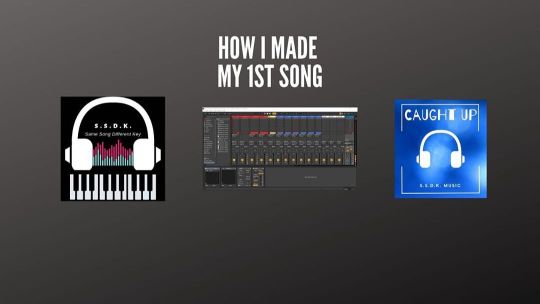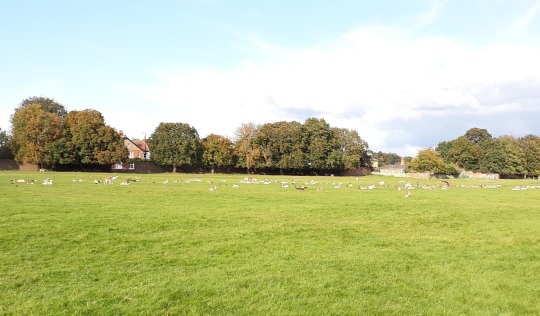#musictutorials
Explore tagged Tumblr posts
Text
Comprehensive Beginner’s Guide to Music Production in FL Studio: Step-by-Step Tutorial
Music production can feel intimidating for beginners, but with the right tools and guidance, it’s easier than you might think. FL Studio, one of the most popular digital audio workstations (DAWs), is a great platform to start producing your own music. This step-by-step tutorial will walk you through the basics of FL Studio, from setting up your project to exporting your first track.
Step 1: **Download and Install FL Studio**
Before you can start producing, you need to download and install FL Studio from the official **Image-Line website**. Choose the edition that suits your needs (the free trial version is fully functional but doesn’t allow you to reopen saved projects). Once installed, open the software, and you’ll see the main workspace where your creative journey begins.
Step 2: **Familiarize Yourself with the Interface**
The interface of FL Studio can be overwhelming at first, but understanding its key components will make navigation much easier. Here are the main areas:
- **Channel Rack**: Where you create your beats and patterns using instruments and samples.
- **Piano Roll**: Allows for detailed editing of notes and melodies.
- **Playlist**: The arrangement window where you place your patterns and audio clips to build your song.
- **Mixer**: Where you control the volume, panning, and effects of each track.
- **Toolbar**: Includes transport controls (play, stop, record) and various tools for editing.
Step 3: **Set Up Your Project**
Start by setting up your project:
1. **BPM (Beats Per Minute)**: Set the tempo of your track by adjusting the BPM at the top of the interface. Most pop songs are around 120 BPM, but you can adjust this based on your genre.
2. **Add Instruments**: In the **Channel Rack**, click the + button to add instruments (synths, drums, etc.). FL Studio includes a wide range of built-in instruments, such as **FL Keys**, **3xOsc**, and **Fruity DrumSynth Live**.
3. **Save Your Project**: Always remember to save your project regularly. Go to **File > Save As** and give your project a name.
Step 4: **Create Your First Beat**
Let’s start by creating a simple drum beat:
1. In the **Channel Rack**, select a drum sample (FL Studio provides a wide variety of samples in the **Browser** on the left).
2. Click on the individual steps in the **Step Sequencer** to create a rhythm (for example, place a kick drum on steps 1 and 9, and a snare on steps 5 and 13).
3. Press **Play** to listen to your beat.
You’ve just created your first drum pattern!
Step 5: **Add Melodies and Chords**
Next, let’s add some melodies and chords using the **Piano Roll**:
1. Select the instrument you want to use (for example, **FL Keys** for a piano sound).
2. Right-click on the instrument in the **Channel Rack**, then choose **Piano Roll**.
3. In the **Piano Roll**, click to add notes, adjusting their length and pitch by dragging them. Use the vertical axis for pitch (higher notes are higher up) and the horizontal axis for timing.
4. Experiment with different chords and melodies to complement your beat.
Step 6: **Arranging Your Song in the Playlist**
Now that you have a few patterns, it’s time to arrange them into a song:
1. Open the **Playlist** by clicking the **View Playlist** button (located in the toolbar).
2. Drag your patterns from the **Channel Rack** into the **Playlist**. You can copy and paste patterns, move them around, and create variations.
3. Organize your patterns into sections (e.g., intro, verse, chorus). This will give your track structure and flow.
Step 7: **Mixing Your Track**
Mixing is where you balance the levels of your different tracks and add effects to improve the overall sound.
1. Open the **Mixer** by clicking the **View Mixer** button (found in the toolbar).
2. Assign each of your instruments and samples to a separate **mixer track**. Do this by clicking on the instrument in the **Channel Rack** and adjusting the track number at the bottom.
3. In the **Mixer**, adjust the volume of each track so that nothing is too loud or too quiet. You want your track to sound balanced.
4. Add effects (reverb, compression, EQ, etc.) to each track by selecting the **FX slots** in the Mixer. FL Studio has a variety of built-in effects to experiment with.
Step 8: **Exporting Your Track**
Once you’re happy with your arrangement and mix, it’s time to export your song as an audio file.
1. Go to **File > Export**, and choose your preferred format (WAV or MP3).
2. Adjust the export settings (bit rate, quality, etc.) if needed, then click **Start** to export.
Congratulations! You’ve just created and exported your first track in FL Studio!
Step 9: **Continue Experimenting**
FL Studio is a powerful DAW with countless possibilities. Once you’re comfortable with the basics, start exploring more advanced features like automation, sound design, and complex arrangements. Don’t be afraid to experiment with new sounds and techniques to develop your own unique style.
Conclusion
Music production in FL Studio can be incredibly rewarding, especially once you get the hang of the workflow. By mastering the basics like creating beats, melodies, and mixing, you’ll be well on your way to producing professional-quality music. Keep practicing, experimenting, and learning new techniques, and you’ll quickly see progress in your production skills!
#MusicProduction#HomeStudio#AudioEngineering#LearnMusicProduction#FLStudio#MusicCreation#DigitalAudio#MusicTutorial
0 notes
Text
Another 5 common mistakes when mixing:
POOR PANNING DECISIONS
Making the mix feel lopsided or crowded.
IGNORING THE IMPORTANCE OF MIDRANGE
Where most of the audible content lies.
NEGLECTING THE LOW END
Leading to a weak or muddy mix.
OVERPOWERING HIGH FREQUENCIES
Causing listener fatigue.
NOT CONSIDERING THE SONGS EMOTION
Disconnect between the mix and the music's feel.
Search any of these online for futher information.
instagram
#singer#music#songwriter#songwriting#producer#singers#musicproducer#musician#musicians#songwriters#Tips#Music Tips#MusicTips#Tricks#MusicTricks#Music Tricks#Tutorial#MusicTutorial#Music Tutorial#MusicProduction#Music Production#OnlineMusicProduction#Online Music Production#Online Music Production Services#OnlineProducer#Online Producer#RecordingStudio#Recording Studio#Online Recording Studio#Instagram
1 note
·
View note
Video
youtube
Minor Scale Chords in Sa Re Ga Ma: A Complete Guide
#youtube#minorscale chords saregama minor musictheory chordprogressions learnmusic musictutorial indianclassicalmusic music musiceducation p
0 notes
Text
youtube
Hey there, music enthusiasts! Welcome back to my channel, the place where we explore the limitless possibilities of music. In today's video, we're diving deep into the world of YouTube Music and discovering how it can be a game-changer in unlocking your musical potential. If you're ready to take your creativity to the next level, you're in the right place. Before we jump in, make sure to hit that subscribe button and ring the bell to stay updated with our musical journey. Now, let's get started! #musicinspiration #YouTubeMusicGuide #UnlockYourPotential #CreativePlaylist #musicaljourney #discovernewmusic #YTMusicTips #CollaborateInMusic #MusicalNetworking
#music discovery#YouTubeMusicGuide#UnlockYourPotential#CreativePlaylist#YouTubeMusicDiscovery#CreateWithYouTube#musictutorial#musicalcollaboration#PlaylistIdeas#YTMusicCommunity#musiclearning#InspirationalMusic#unlockcreativity#MusicCollaborators#BehindTheMusic#YTAlgorithm#MusicalInfluences#musiceducation#YTMusicJourney#CreativeProcess#playlistcuration#YTInnovation#MusicalConnections#YTMusicCreativity#DiscoverWithYouTube#yt#ytmusic#viral#viralvideo#vdjmondo
0 notes
Text
Check out the 90s House Tutorial on how to create a classic house Beat with Stock Plugins and the help of AI.
Only on: www.LoopLands.com
#90shousemusicproduction#houseproduction#aimusicproducer#musicproducerworkingwithai#innovatorsoundmatchi#jamahook#musictutorial#howtomakehousemusic#tinderformusic
0 notes
Photo

#GoldenTouchMusicTV #MusicLovers #ArtistStories #MusicTutorials #YouTubeChannel The channel also serves as a platform to showcase emerging artists, giving fresh talent a chance to shine. With engaging music videos and live performances, Golden Touch Music TV introduces viewers to new and exciting sounds from various genres.
0 notes
Link
Hi Everyone, In this video, SkillDosti music instructor - Dipti is going to answer the most asked questions by new students or professionals that are - "How can I learn music online at home?" or "Can I learn music online?", " How can I improve my Singing?' etc...
Before this question hits your head too, Get the answer by watching this short & quick video about Live Music Online Classes.
Thank you for watching the video.
Like & Share the video with your friends, family who are passionate about music and wants to learn music online without missing their schools or jobs.
About us: A new way to learn what you like most. Photography, Digital Marketing, Guitar, Yoga, and many more creative courses. SkillDosti offers a platform where any student or professional can attend live classes for creative courses from anywhere and anytime.
Our Creative Platform: https://onlinecourses.skilldosti.com
☎: +91 - 9899898313
To Explore Jobs & Freelancing in Creative Industries, visit https://www.skilldosti.com
#creativecourses#skilldosti#finearts#liveclasses#music#indianmusic#learnmusic#musiccourse#musicclasses#musictutorials
1 note
·
View note
Photo

"Remember when everything was beige? In the early-2000s, when I was a teenager, everything seemed to be painted beige. My house was beige, my friend’s houses were beige, the school interior — beige. At the time, the trend was to renovate everything with a mind-numbingly mundane color palette in order to “increase resell value.” Kate Wagner describes this really well in ‘How Beige Took Over American Homes’ on Atlas Obscura. This obsession with neutrality is fascinating in a way… why would people want their living environment to be soulless and bland? And why did society perceive conformity as more valuable than uniqueness?" Kicking off a new series of interviews and tutorials over at Forestpunk with a super interesting, insightful, and USEFUL conversation about recording shoegaze music as well as a ton more fascinating ideas around the current state of music and culture! REALLY proud of this one! MAJOR thanks to @darks0ft and @lookuprecords for the interview. And make sure to check out Darksoft's wonderful new album, Beigeification, which came out on Friday the 13th! Highest possible recommendation. Click the Link In Bio to read the full interview! Hoping to make this an ongoing series. Get in touch at [email protected] if you'd like to be featured for both tutorials as well as general interviews! . . . . . #Darksoft #Beigeification #LookUpRecords #Portland #PortlandMaine #Interviews #Tutorial #Tutorials #Shoegaze #DreamPop #BedroomPop #Recording #Production #ProductionTips #ProductionTechniques #MusicTutorials #MusicTips #RecordingTips #Recording #RecordingTips #RecordingTechniques #ShoegazeGuitars #GuitarPlayers #GuitaristsOfInstagram #ProducersOfInstagram #soundengineering #shoegazeproduction #JSimpson #musicjournalism #Forestpunk https://www.instagram.com/p/CoGqt27uhIX/?igshid=NGJjMDIxMWI=
#darksoft#beigeification#lookuprecords#portland#portlandmaine#interviews#tutorial#tutorials#shoegaze#dreampop#bedroompop#recording#production#productiontips#productiontechniques#musictutorials#musictips#recordingtips#recordingtechniques#shoegazeguitars#guitarplayers#guitaristsofinstagram#producersofinstagram#soundengineering#shoegazeproduction#jsimpson#musicjournalism#forestpunk
1 note
·
View note
Video
youtube
(via https://www.youtube.com/watch?v=fQ3FiRUleCI)
And here it is! My first video. No secrets leaked yet! The secrets start next week. Lol. It's a simple introduction to my channel and what I'll be covering moving forward. If you guys have any topics you'd like me to cover, simply reach out and I'll do my best to cover them in future episodes. Cheers!!
Varti
1 note
·
View note
Text
Step-by-Step Guide on Turning Simple Loops into Full Songs for Music Producers
As a music producer, starting with a simple loop is a common approach when building a new track. Loops provide the foundation for a song, but the real challenge is expanding that loop into a full composition. Whether it’s an inspiring melody, a catchy rhythm, or a hypnotic bassline, transforming your loop into a finished song requires structure and creativity. Here's a step-by-step guide to help you turn a simple loop into a fully developed track.
1. **Start with a Strong Loop**
Before diving into the full song, ensure your loop is solid and captivating. It should have a strong core element, such as a memorable melody, bassline, or drum pattern. The loop acts as the main theme or "hook" of your song.
**How to Build a Strong Loop:**
- **Layer different elements:** Start with a basic drum beat, then add a bassline, melody, chords, and other elements. Each layer should complement the others while standing out individually.
- **Balance frequencies:** Ensure your loop has a full-spectrum sound. For example, use sub-bass for the low end, mid-range instruments like guitars or synths, and higher-frequency elements like hi-hats or atmospheric effects.
- **Keep it interesting:** Even though loops are repetitive, they should be interesting enough to form the backbone of your song. Make sure it captures the listener's attention.
2. **Expand the Loop into a Song Structure**
Now that you have a strong loop, it’s time to stretch it out into a full song. The key is to develop a structure with various sections like verses, choruses, and bridges.
**Popular Song Structures:**
- **Verse-Chorus-Verse-Chorus-Bridge-Chorus**: One of the most common structures in modern music.
- **Intro-Verse-Chorus-Verse-Chorus-Breakdown-Chorus**: Ideal for electronic music or dance tracks.
- **Intro-Build-Drop-Build-Drop-Outro**: Typical for genres like EDM or trap.
**How to Expand the Loop:**
- **Divide your loop:** Use your loop as the basis for the main sections (verse or chorus). Then, create variations for other sections by adding or removing elements.
- **Use automation:** Automating filter sweeps, volume, or panning can add dynamics and keep the listener engaged throughout the track.
- **Introduce new elements:** Each section of the song should introduce subtle changes. For instance, adding a new instrument or effect in the chorus differentiates it from the verse.
3. **Build Tension and Release**
A song should have natural peaks and valleys, keeping listeners engaged by building tension and releasing it at key points. The contrast between sections, like a softer verse and a powerful chorus, creates excitement.
**How to Create Tension and Release:**
- **Breakdowns and drops:** In genres like electronic or dance music, a breakdown followed by a drop can be an effective way to release tension. Remove some layers during the breakdown, and reintroduce them (often with more energy) during the drop.
- **Volume and intensity shifts:** Gradually increase the intensity (like adding percussion or a louder synth) leading up to the chorus, then reduce it again during the next verse to keep the song dynamic.
- **Using effects:** Reverb, delay, and other effects can create atmospheric tension, especially when slowly building or cutting them back during transitions.
4. **Introduce Variations and Change-Ups**
A song can feel repetitive if the same loop is played throughout the entire track. Introduce subtle (or sometimes drastic) variations to keep the listener's attention.
**How to Add Variations:**
- **Melodic changes:** Alter the melody or harmony in different sections to keep the song fresh.
- **Rhythmic variations:** Change up the rhythm or drum pattern in the chorus or bridge to differentiate it from the verses.
- **Layering and subtracting elements:** Add new layers of sound for certain sections and remove them for others to create contrast. For example, remove the bass during a breakdown or introduce a new synth line in the chorus.
5. **Focus on Transitions**
Smooth transitions between sections are crucial in keeping the song flowing. Abrupt changes can disrupt the listening experience, so it’s important to use transition effects and techniques.
**How to Create Smooth Transitions:**
- **Use risers and impacts:** Sound effects like risers or impact sounds (like a crash) can signal a shift from one section to another, making transitions feel seamless.
- **Volume automation:** Gradually fading out one section while bringing in the next creates a natural flow.
- **Reverse effects:** Reversing sounds, such as cymbals or vocals, can build anticipation before transitioning to a new section.
6. **Fine-Tune the Arrangement**
Once the basic structure is in place, fine-tune the arrangement by paying attention to detail. Small adjustments can significantly improve the overall feel of the song.
**How to Fine-Tune the Arrangement:**
- **Balance the mix:** Ensure that each element is sitting properly in the mix. Vocals should be clear, bass should be punchy, and no element should overpower the others.
- **Use EQ and compression:** These tools can help tighten up individual elements and make the overall track sound cohesive.
- **Listen critically:** Play through the track multiple times and take notes on what feels too repetitive or too abrupt. Adjust accordingly.
7. **Add Ear Candy and Final Touches**
Ear candy refers to small, subtle elements that add flavor to your track. These can be unexpected sounds, melodic fills, or rhythmic accents that make the song more engaging.
**Ideas for Ear Candy:**
- **Vocal chops or samples:** Chop up vocal lines and place them as fills or accents throughout the track.
- **Percussive fills:** Add short percussive fills or stutter effects between sections to surprise the listener.
- **Ambience and texture:** Atmospheric pads, vinyl crackle, or distant reverb effects can add depth and richness to your track.
8. **Finalize the Song**
Once your track is fully arranged and polished, it’s time to finalize it. This involves the last round of mixing and preparing the track for mastering.
**Final Steps:**
- **Listen on different devices:** Play your song on headphones, speakers, and other systems to ensure it sounds great across all formats.
- **Bounce a rough mix:** Export a draft version and listen with fresh ears a day later. This will help you catch any mistakes or areas that need improvement.
- **Prepare for mastering:** After you’re satisfied with the mix, prepare it for mastering by ensuring there's no clipping and that the track has some headroom (-6dB is ideal).
Final Thoughts
Turning a simple loop into a full song is a process that requires both creativity and technical skill. By focusing on song structure, variations, transitions, and fine-tuning, you can expand your loop into a complete, professional track. With patience and attention to detail, your loops can evolve into engaging, dynamic songs that captivate listeners.
#MusicProduction#SongwritingTips#LoopToSong#MusicProducers#CreativeProcess#MusicComposition#SongStructure#ProducerLife#MusicTutorial#SoundDesign
0 notes
Video
youtube
Major Scale Chords in Sa Re Ga Ma: A Complete Guide
#youtube#majorscale chords saregama musictheory chordprogressions learnmusic musictutorial indianclassicalmusic music musiceducation piano
0 notes
Photo

Seguimos con los tutoriales! En esta oportunidad hablo sobre la pirámide del ritmo y el cifrado de compás! Para todos los interesado en leer música y aquellos que quisieran saber a qué demonios se refieren los músicos cuando cuentan! Si te gusta suscríbete, dale like y comparte! La edición de vídeo fue gracias a @nana.musik Síganla por su cuenta de Instagram y por su canal de Youtube nana musik. Graciaaas!! Enlace en mi bio 🔝🔝🔝🔝🔝🔝🔝 #tutorial #musicaparatodos #ritmos #cifrado #compas #musictutorials #contenidodigital #ritmica https://www.instagram.com/p/COESfBeDmPW/?igshid=17gtyqhmhv7o1
0 notes
Photo

Check out my Youtube tutorial on how I created my song ”Caught Up”. The link is in my bio. . . . . . #musictutorial #musictutorials #howto #howimade #song #music #originalmusic #writingmusic #composingmusic #musicproducer #musicproduction #banger #musiccomposer #ableton #abletonlive #abletonlive10 #abletonproducer #abletonproducers #musicstudio #musicproduction #musicians #musiclife #musicismylife Direct Link to youtube: https://youtu.be/86DX-4CCFSU (at Stockton, California) https://www.instagram.com/p/B-PqZbKjmJJ/?igshid=b0latud58h90
#musictutorial#musictutorials#howto#howimade#song#music#originalmusic#writingmusic#composingmusic#musicproducer#musicproduction#banger#musiccomposer#ableton#abletonlive#abletonlive10#abletonproducer#abletonproducers#musicstudio#musicians#musiclife#musicismylife
0 notes
Photo

What is the basic theory of Indian classical music? What are the types of Indian classical music? How many notes are there in it? Why should anyone learn it? We will be posting the next lesson of the series soon. Stay Tuned! Happy SkillDostiing! #classicmusic #indianclassicalmusic #hindustaniclassicalmusicarchieves #hindustaniclassicalmusic #musiclessons #indianclassicalmusic #classicalvocal #learnmusic #learnmusictheory #musictutorials #skilldosti #northindianclassicalmusic #musicnotes https://www.instagram.com/p/BzATtFPlsm4/?igshid=19bk3kkdyrnpt
#classicmusic#indianclassicalmusic#hindustaniclassicalmusicarchieves#hindustaniclassicalmusic#musiclessons#classicalvocal#learnmusic#learnmusictheory#musictutorials#skilldosti#northindianclassicalmusic#musicnotes
0 notes
Photo

Beauties of London #Electronicmusic #producers #musictutorial #music #London #ableton #abletonlive #academy #festivals #lessons #enfield #lifestyle #love #dance #fabric #party #ibiza #bits #hashtag #knowledge #pub #events #tutorials #free #musicproduction #musiclessons #festivals (at Kingston upon Thames) https://www.instagram.com/p/CU8MdjFMynX/?utm_medium=tumblr
#electronicmusic#producers#musictutorial#music#london#ableton#abletonlive#academy#festivals#lessons#enfield#lifestyle#love#dance#fabric#party#ibiza#bits#hashtag#knowledge#pub#events#tutorials#free#musicproduction#musiclessons
2 notes
·
View notes
Text
Playing the piano is so much more than just picking up notes on the keys.
Sound, look, and feel your best by following good piano posture that is just as vital.
Watch and pay attention as your teacher keyboardist Noel Prashanth from the Demoz School of Music demonstrates the right way and techniques. Get the posture right and you can play with expression and a vast dynamic range.
Subscribe to our YouTube channel www.youtube.com/c/zelusacademy and watch these curated training videos for free! Follow us for the latest updates on upcoming episodes.
#keyboardist#piano#pianotutorial#musicinstruments#musicinstrument#musicinstagram#keyboard#instrumentplaying#musictutorial
2 notes
·
View notes